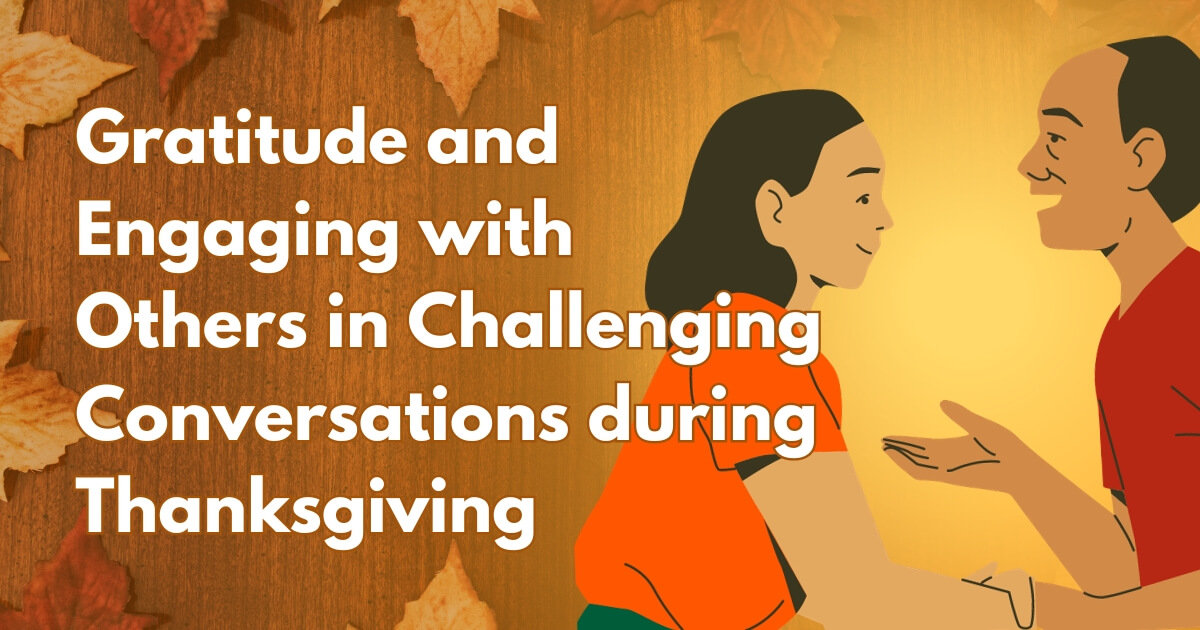Gratitude and Engaging with Others in Challenging Conversations during Thanksgiving

[Editor’s Note: Here on our blog, MCN’s Director of Witness to Witness, Kaethe Weingarten, PhD, shares stories, resources, and helpful tips to support health care workers through the many stressors of their daily lives. In this article, we jump out of the exam rooms and into our living rooms, for an article to support awareness and engagement with family and friends during the holidays. Dr. Weingarten also offers a newsletter (called the W2W Update), filled with resources, recent articles, and her news and views.]
A world day of gratitude was first celebrated in 1965 but only became a United States holiday, probably in conjunction with Thanksgiving, fifty years later in 2015. November is National Gratitude Month and also the month in which many people in the United States celebrate Thanksgiving. Thanksgiving is a holiday that many families and friends -- but certainly not all -- use as a time of gathering to enjoy each other's company and eat wonderful food. This year, once again, the gathering of family and friends may be fraught with conflict as political polarization, even small differences of opinion, threaten the pleasures of connection.
I have been wondering if there is a way of using what we understand about the science and experience of gratitude to help navigate the political differences that may surface even as soon as folks remove their coats and pull up their chairs. I decided to investigate the components of gratitude to see if they might illuminate how gratitude could play a helpful role in being in the presence of political differences among people we care about enough to invite to our homes or visit in theirs. Might there be some helpful hints to reduce emotional reactivity when we are with people with whom we strongly disagree on issues that are important to us?
Surprisingly, I found more helpful ideas in an article about how to teach children to be grateful than in the substantial literature on the science of gratitude per se. The articles explaining what gratitude is, covering such topics as its origins, individual factors that are associated with it, benefits that individuals derive from gratitude, social and cultural underpinnings for gratitude with their linked benefits, and interventions that promote gratitude didn’t offer as much help as an interview with Andrea Hussong articulating how we can support the development of gratitude in children.
Dr. Hussong is a developmental scientist and psychologist at the University of North Carolina at Chapel Hill, where she directs the Raising Grateful Children project. The project aims to identify what parental practices teach children about gratitude. Their studies break gratitude down into its component parts, and in doing so I found something of relevance to my quest. They identified that children have to notice that they have been given something. That is, they have to become aware that they have received something and then make meaning of it in such a way that the meaning yields a positive emotion. That positive emotion also connects to an awareness that you aren’t being asked to give back what you were given. You are not indebted to the giver. When this sequence happens, you may experience gratitude for what you have received. This may or may not lead to behaviors that express gratitude.
In this paradigm, awareness --noticing that something is being given – and learning to make positive meaning of it is key. In some respects, it may be more important than teaching the behavioral part -- the visible part of the iceberg, if you will, of teaching children to say, “thank you.” “Thank you” is about manners, which is definitely important. But helping children learn to see that they are being given something of value teaches them to discern what is below the visible tip of the iceberg.
An example may illustrate the point. I have a grandchild who lives in a state where there are no dramatic fall colors. Yesterday, a friend of mine texted me four photos of spectacular fall color displays. I texted them to my grandchild right away. She may enjoy these photos – she texted back, “beautiful” – but I also hope she received the message that her grandmother always has her “in mind.” It would be great if she felt, “My grandmother knows me well and is always thinking about me and how she can support me.” That thought would be an expression of what lies below the tip of the iceberg.
Becoming aware of what is below the tip of the iceberg may be just what we need to handle those times when we are in the presence of people whose views we dislike. I can put it another way. What is the gift we are being given when we have an opportunity to talk with and listen to the people with whom we disagree?
Sandro Galeo is a physician, epidemiologist and author, and Dean of the Boston University School of Public Health, who has published extensively on the consequences of mass trauma and conflict all over the world. In a recent Substack column he discusses how important talking respectfully across differences is at precisely these moments when reactivity is high. He writes, “If there ever was a time for such conversations, it is surely now, when it feels like in many respects the world is on fire.” So how does gratitude fit into a call for respectful, civil talk, even debate, at the Thanksgiving dinner table?
It fits because below the tip of the iceberg—which may well be intensely felt differences of foundational beliefs – we are sitting down with people we care about who are willing to engage with us on topics that are of paramount importance to all of us. We are sitting with people we care about and who care about us, who are willing to make themselves vulnerable by sharing what deeply matters to them. That is what is below the tip of the iceberg. If we can feel that, if we can let in that awareness, we will know we have a great deal to be thankful for even while our voices may be getting louder and it looks like we are not going to come to any kind of agreement on the topics we are discussing.
Or, we may feel that way but someone at the table doesn’t seem to want to get in touch with that spirit of caring for the other. You may be trying your best, your voice is carefully modulated, but the other person is starting to wind up and have a very unpleasant look on their face. The hosts may be looking tense. Caring about the entire situation may mean suggesting a pause or even a full stop. Not everyone is willing, ready, or able to talk about topics they have strong feelings about. Being willing to drop back and relinquish the conversation may be the kindest thing to do and one that will probably elicit gratitude from others.
The awareness that we need to, well, be aware of, is that we care about each other. The awareness is about how essential it is to have respectful dialogue precisely at times like these, at times when there is so much despair over the violence that is happening in so many places in the world, perhaps even in our own communities. The awareness is about the likelihood that these kinds of difficult conversations, held with an appreciation that we are having them at all, will contribute to a healthier world. That is how I link our observance of this month of gratitude with the intensity of the political polarization that threatens to split us, just when we need to feel united in what matters most: caring connection. I hope your Thanksgiving table is full of wonderful food, family, friends, and an acute awareness of the caring that likely lies below the dissenting tips of the icebergs that may also be present at your festive holiday tables.
Resources
The following resources provide concrete suggestions as to how to engage with others in challenging conversations, especially when the times themselves are difficult. The Witness to Witness webpage also has resources that can be valuable at this time.
- Conversations in Trouble Times: A conversation guide from Living Room Conversations.
- List of Questions to Generate Gratitude: 100 prompts by Joel Wong, PhD.
- Eleven Tips for Making a Hard Conversation Work: A guide from Essential Partners
- Guide to Dialogue Across Generations: Another Essential Partners guide which focuses on talking across “strong, overlapping generational identities.”
- To Have a Healthier Conversation About the Israel-Hamas War in Gaza: Particularly relevant for many families this year.
- Log in to post comments

